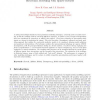Free Online Productivity Tools
i2Speak
i2Symbol
i2OCR
iTex2Img
iWeb2Print
iWeb2Shot
i2Type
iPdf2Split
iPdf2Merge
i2Bopomofo
i2Arabic
i2Style
i2Image
i2PDF
iLatex2Rtf
Sci2ools
108
click to vote
ML
2002
ACM
2002
ACM
Structural Modelling with Sparse Kernels
A widely acknowledged drawback of many statistical modelling techniques, commonly used in machine learning, is that the resulting model is extremely difficult to interpret. A number of new concepts and algorithms have been introduced by researchers to address this problem. They focus primarily on determining which inputs are relevant in predicting the output. This work describes a transparent, advanced non-linear modelling approach that enables the constructed predictive models to be visualised, allowing model validation and assisting in interpretation. The technique combines the representational advantage of a sparse ANOVA decomposition, with the good generalisation ability of a kernel machine. It achieves this by employing two forms of regularisation: a 1-norm based structural regulariser to enforce transparency, and a 2-norm based regulariser to control smoothness. The resulting model structure can be visualised showing the overall effects of different inputs, their interactions, a...
Machine Learning | ML 2002 | Non-linear Modelling Approach | Sparse Anova Decomposition | Statistical Modelling Techniques |
Related Content
| Added | 22 Dec 2010 |
| Updated | 22 Dec 2010 |
| Type | Journal |
| Year | 2002 |
| Where | ML |
| Authors | Steve R. Gunn, Jaz S. Kandola |
Comments (0)

